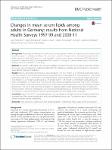Changes in mean serum lipids among adults in Germany: results from National Health Surveys 1997-99 and 2008-11
Truthmann, Julia
Schienkiewitz, Anja
Busch, Markus A.
Mensink, Gert
Du, Yong
Bosy-Westphal, Anja
Knopf, Hildtraud
Scheidt-Nave, Christa
Background: Monitoring of serum lipid concentrations at the population level is an important public health tool to describe progress in cardiovascular disease risk control and prevention. Using data from two nationally representative health surveys of adults 18–79 years, this study identified changes in mean serum total cholesterol (TC), high-density lipoprotein cholesterol (HDL-C), and triglycerides (TG) in relation to changes in potential determinants of serum lipids between 1997–99 and 2008–11 in Germany. Methods: Sex-specific multivariable linear regression analyses were performed with serum lipids as dependent variables and survey wave as independent variable and adjusted for the following covariables: age, fasting duration, educational status, lifestyle, and use of medication. Results: Mean TC declined between the two survey periods by 13 % (5.97 mmol/l vs. 5.19 mmol/l) among men and by 12 % (6.03 mmol/l vs. 5.30 mmol/l) among women. Geometric mean TG decreased by 14 % (1.66 mmol/l vs. 1.42 mmol/l) among men and by 8 % (1.20 mmol/l vs. 1.10 mmol/l) among women. Mean HDL-C remained unchanged among men (1.29 mmol/l vs. 1.27 mmol/l), but decreased by 5 % among women (1.66 mmol/l vs. 1.58 mmol/l). Sports activity and coffee consumption increased, while smoking and high alcohol consumption decreased only in men. Processed food consumption increased and wholegrain bread consumption decreased in both sexes, and obesity increased among men. The use of lipid-lowering medication, in particular statins nearly doubled over time in both sexes. Among women, hormonal contraceptive use increased and postmenopausal hormone therapy halved over time. The changes in lipid levels between surveys remained significant after adjusting for covariables. Conclusion: Serum TC and TG considerably declined over one decade in Germany, which can be partly explained by increased use of lipid-lowering medication and improved lifestyle among men. The decline in serum lipids among women, however, remains unexplained.
No license information

